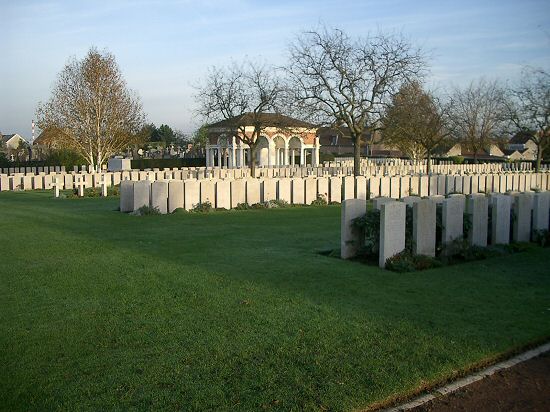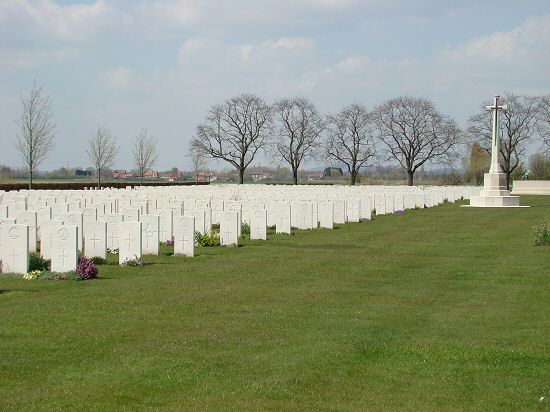|
Many Guernsey families had more than one son who fought
and died in the Great War and there were also families
where father and son fought and were both lost. But the
Salmon family of St Peter port seems to have suffered
more than most. They lost four sons between January, 1916
and April, 1918, the last two on following days.
In 1891 John Salmon age 42 and born in St Martin's in
Jersey and Emily his wife age 32 and born at Trinity,
also in Jersey were living at 10 Hauteville, St Peter
Port. Their family consisted of:
- John age 13, a messenger boy at the port
- Walter age 12, also a messenger boy
- William age 5, a scholar
- Bertie, age 3, and
- Emeline, age 10 months.
|
John was born at St Peter's in Jersey
but the other children were born in Guernsey.
By 1901 the family, still living at 10, Hauteville, St
Peter Port, now consisted of:
- John L Salmon, a mason, age 54, and born in
France,
- His wife Emily, age 40, born at Trinity in Jersey,
and their children:
- Walter J, a plasterer age 20,
- William J age 15, an errand boy at the port
- Albert J age 13, also an errand boy
- Emily A, age 12
- George H, age 8
- Alfred J, age 3, and
- Arthur, age 1.
|
The information from this census shows that John Salmon
Junior had left home, and George, Alfred and Arthur were
new additions to the family. It also indicates some discrepancies
over the age of the parents and where John Salmon Senior
was born.
By 1911 the family had moved into three rooms at 26 Pedvin
Street, St Peter Port and living at home with Emily who
was officially listed as head of household (though she
lists herself as wife, married for 35 years) were:
- Albert John, age 23, a tin worker,
- Emily Ada age 21,
- George Henry age 18, a shop porter,
- Alfred James age 14, an errand boy,
- Arthur James age 11, at school,
- Alice Beatrice, age 7, and
- Percy age 1
|
So Walter and William had also left home by this date,
and Alice and Percy were the new additions. This census
also states that John and Emily had had thirteen children
of who ten were alive in 1911. John Junior was married
to Lilian, née Druce and had three children, and
was living at Cliff Terrace, St Peter Port, Walter was
married to Roseline and also had three children, and William
was married to Alice, Roseline's sister, and had two children.
The two families lived together at Sutherland House, Victoria
Terrace in St Peter Port, with the younger siblings of
the wives boarding with them.
So when war broke out in 1914, there were seven Salmon
brothers of whom two were too young to serve. By the end
of the war only John, who was 40 by this time, Arthur,
age 18 and Percy age 8 remained. All those in between
were lost in the intervening four years. Arthur was just
old enough to serve with the RGLI, going over to France
just before the Armistice and after four of his brothers
had died.
|
The family suffered its first loss on 1st January,
1916, when 10809 Lance Corporal Walter John Salmon
of the 9th Battalion, Royal Fusiliers died of wounds
sustained at the age of 35.
He had been in France for barely six months, having
arrived on 15th June, 1915. From September, 1915
his unit, part of the 12th (Eastern) Division, was
involved in battles in the Loos area, during which
period 117 officers and 3237 men from the Division
were killed or wounded. On the 21st October the
Division had been relieved and moved to Fouquieres-les-Bethune.
It took over the Hohenzollern Redoubt front after
a very short rest of five days and spent a cold,
wet and miserable month here before being relieved
on the 15th November by 15th (Scottish) Division,
whereupon it moved into reserve at Lillers. On the
9th December, his Battalion was given the unusual
task of assisting in a round-up of spies and other
uncertain characters in the streets of Bethune.
Next day the Division moved up and relieved 33rd
Division in the front line north of the La Bassee
canal at Givenchy. Between the 12th December, 1915
and the 18th January, 1916 in a quiet period of
trench-holding, the Division nonetheless suffered
the loss of 102 officers and 670 men killed, wounded
or missing. Walter Salmon was wounded at some time
during this period and died of wounds on 1st January,
1916.
He is buried at Bethune Town Cemetery in Northern
France. For much of the First World War, Bethune
was comparatively free from bombardment and remained
an important railway and hospital centre, as well
as a corps and divisional headquarters. The 33rd
Casualty Clearing Station (CCS) was in the town
until December, 1917, and this may well be where
he was taken after being wounded, especially since
an "In Memoriam" notice in a Guernsey
newspaper notes that he died in "a casualty
clearing station". He earned the 1915 Star,
British War Medal and Victory Medal for his war
service.
|

Bethune Town Cemetery
|

Corbie Communal Cemetery Extension, Somme
|
Alfred James Salmon was the next
to die. Like many Guernseymen, he served firstly
with the 3rd Battalion, Royal Irish Regiment as
8881 Pte A Salmon then with 'D' Company, of the
7th Battalion, Royal Irish Fusiliers with the
service number 21901.
His service record shows that he
signed up in Guernsey in June, 1915. He was a
19 year old gardener living with his parents at
Rue des Pres in St Peter Port. He went to England
for training at Pirbright Camp in Surrey in 1915
before crossing to France for further training.
By April, 1916 the unit was considered to be fully
trained and went into the front line near Loos,
where they lost several men to gas attacks. At
the end of August, 1916 they were moved to the
Somme. Alfred Salmon received gunshot wounds to
his back here and died of his wounds at 5th CCS
at Corbie, in Picardy, a few miles east of Amiens
on 10th September, 1916. Unfortunately the telegram
notifying his family was initially delivered to
the wrong address. Then there was some confusion
as to whether it was Alfred or George who had
died.
It must have been a very distressing
time for the family with telegrams travelling
back and forth between France, Ireland and Guernsey
until Alfred's death was confirmed. He is buried
at Corbie Communal Cemetery Extension, Somme.
|
|
Sadly George also died eighteen months
later, on 12th April, 1918, at the age of 22. He
was a single man living at home when war broke out.
He served with the 1st (Service) Battalion of the
RGLI as 2516 Pte George H Salmon, having previously
served with the 3rd Battalion, Royal Irish Regiment
(7904) and the 7th Battalion, Royal Irish Fusiliers
(21856).
He was a shop assistant, living at
the family home in St Peter Port when he signed
up on 9th April, 1915. He transferred to the RIF
on 4th October, 1915 and six months later was tried
for allegedly shooting himself in the right hand.
However he must have recovered and remained with
the unit until he was transferred to the RGLI on
its formation at the end of 1916.
He survived the battle of Cambrai
but was killed in action at the Lys on 12th April,
1918.
Like most of the RGLI men who fell
there he has no known grave, but is commemorated
on the Ploegsteert memorial near Ieper in Belgium.
|
Ploegsteert Memorial and Cemetery
|
|

Trois Arbres Cemetery, Steenwerck
|
His brother Albert (Bertie) was also
in the RGLI, serving as 145 Pte AJ Salmon, but he
appears to have joined directly, not via another
regiment. He was also single and still living at
home with the family when war broke out.
He had not only suffered the experiences
of Cambrai, but had also lost three of his brothers
before he himself was killed in action on 13th April,
1918 on the Lys.
He is buried at Trois Arbres Cemetery,
Steenwerck in Northern France.
The Guernsey Weekly Press, reporting
Albert's death, notes that he was the fourth son
killed out of seven.
|
With thanks to the Guernsey Press and
The Priaux Library, Guernsey
|